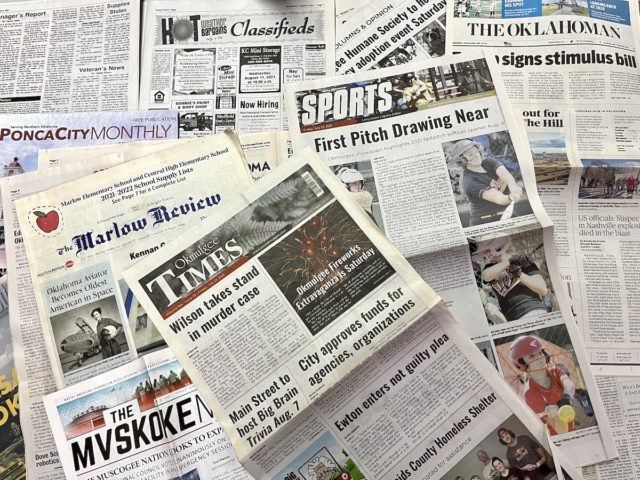
Will newspapers survive? It’s a question that most people in my generation have been asking for years, with evidence considered for the answer becoming more and more grim.
Print circulation is down 30 percent in the last 30 years, and the number of newspaper employees dropped by 50 percent in the last 15 years. In those same years, newspaper advertising shrank to less than 20 percent of what it was in 2005. As a result, it’s no wonder two thirds of the counties in the United States today have no daily newspapers. For the rest, their local papers are often owned by investment groups (the seven largest of which own more than 1,000 papers in 42 states) with few ties to the local community. Many of these papers are heavily leveraged, with any extra profits from cost-cutting going to debt service, pension obligations or overhead at a distant home office.
I heard these bleak figures during a Dec. 2 talk on “the future of local, state and national newspapers” by University of Oklahoma professor and veteran journalist Andy Rieger.
A former editor of The Norman Transcript, Rieger told the Cleveland County Democratic Party’s “cornbread and beans” crowd that he began his journalism career as an assistant paperboy in Norman, folding papers for a carrier before he got his own route, became a reporter and eventually led the newsroom of his hometown paper. He was nice enough to share the slides from his presentation with me when I said I wanted to write about the changing media landscape.
Paywall perception problems
Industries come and go, and businesses regularly consolidate. So why does the newspaper business matter? Among other things, Rieger said, the decline of newspapers should concern us because about 85 percent of all news is first reported by a newspaper reporter. That statistic feels a bit shocking, so alert readers may have the same question that I did: Where does the 24/7 news glut come from, especially with the 50 percent drop in newspaper employees noted above?
“Mostly stealing,” Rieger said. Apparently the term of art is piracy, where a broadcast or online outlet follows a lead generated by a newspaper.
To put the newspaper industry’s revenue decline in perspective, Rieger noted that, adjusted for inflation, newspaper advertising has dropped below 1950 levels. Newspapers are growing their advertising revenue for their digital editions, but not at a pace and value to replace declining print ads, which have historically generated most of a paper’s funding. And classified advertising, formerly a significant print revenue source, seems to have moved permanently to Craigslist and Facebook Marketplace.
According to Rieger, who still writes a column for The Transcript, most readers are largely unaware of the finances of their local newspaper. Only 13 percent of adults in the metropolitan area have paid for news in the past year, according to a Pew Research Center study.
Some readers may simply be confused. Newspapers have struggled to decide how much of their online content should be behind a paywall, and with more nonprofit publications (like NonDoc) relying on charitable contributions and eschewing paywalls as a question of equitable information access, some readers believe news should be free.
By and large, most newspapers initially treated their digital editions and websites almost as an afterthought. Now, however, newspapers have adopted a “web first” mantra. But publishers and advertisers of for-profit website news need high click counts, which can sometimes motivate publications to pursue more shallow articles and fewer pieces chronicling local governments or investigating deeper issues. So-called “click bait” pieces rarely translate well to print editions. And with shrinking newsrooms, those print editions feature less original local content and rely more heavily on wire copy and reprints from nonprofit online publications.
How the masses are communicating
Still, I like to read my local paper on paper. As Rieger pointed out, this is an increasingly expensive preference. Since 2011, more people have read news online than in printed newspapers. Since it costs less to service a digital subscriber than a print one, those who continue to receive a print edition ultimately pay more for that newspaper, especially with print advertising budgets shrinking. Eventually, as Rieger said, the newspaper will no longer be a mass medium if the masses cannot afford it.
Rieger does see a future for online nonprofit news websites. For two decades, he has worked with a foundation that funded many such startups. Most of these have been started by journalists who formerly worked for newspapers or other legacy media. Most rely on foundations and donations, but Rieger foresees that many may not be sustainable with their current revenue model.
Many, of course, does not mean all. Full disclosure: I am a NonDoc donor as well as a content contributor, and I expect to be reading quality Oklahoma journalism from this site for many years to come.
I just hope I can continue subscribing to my local newspapers as well.






















